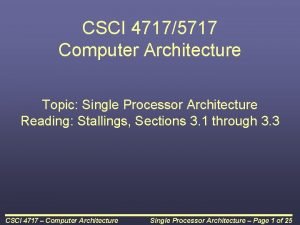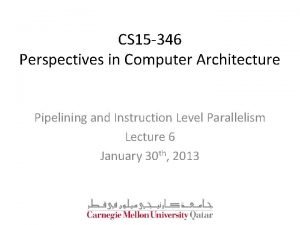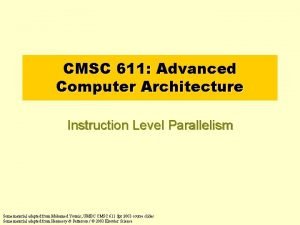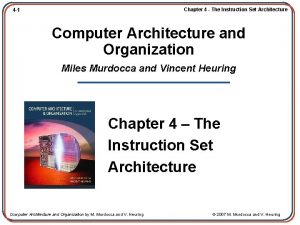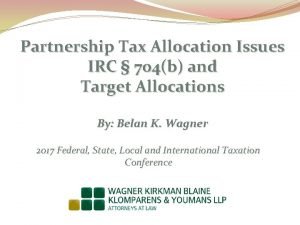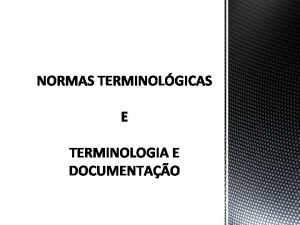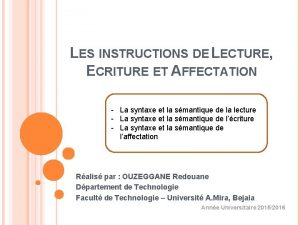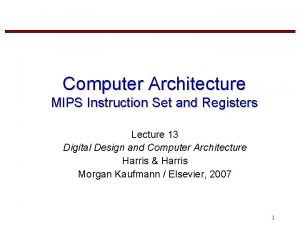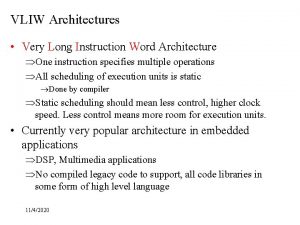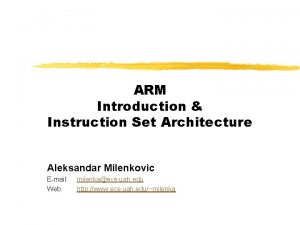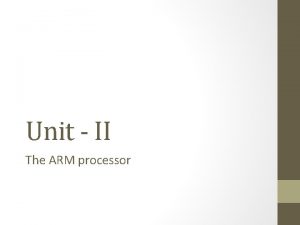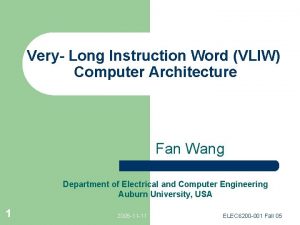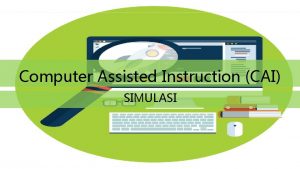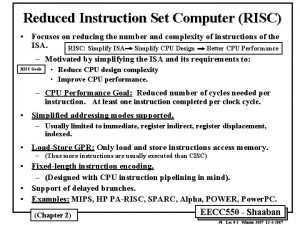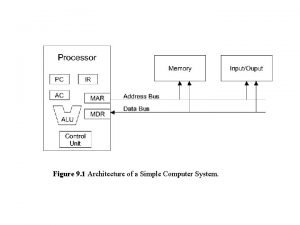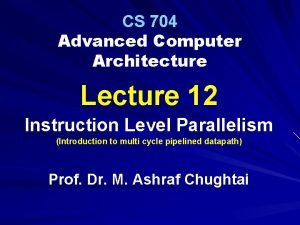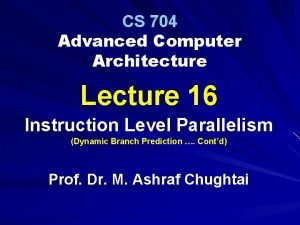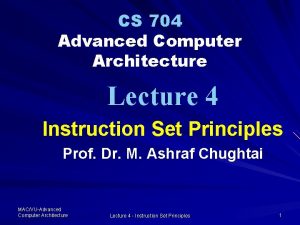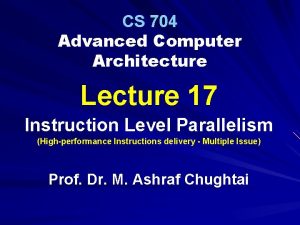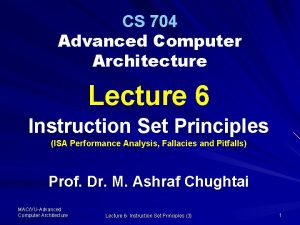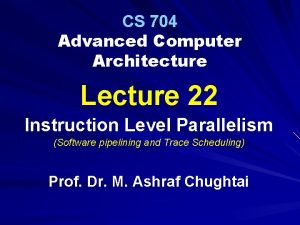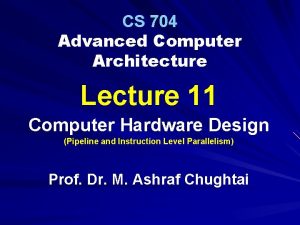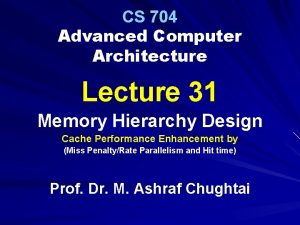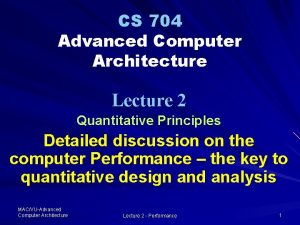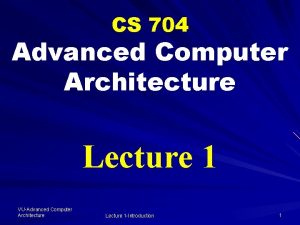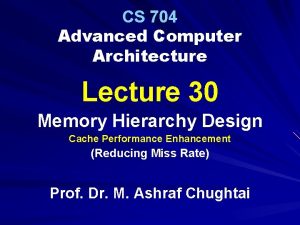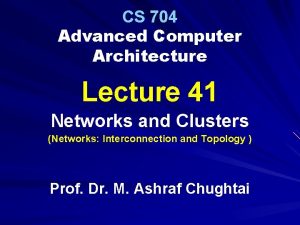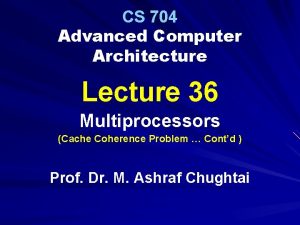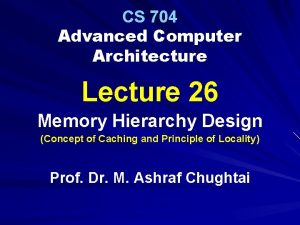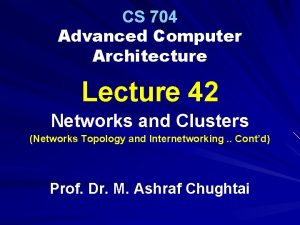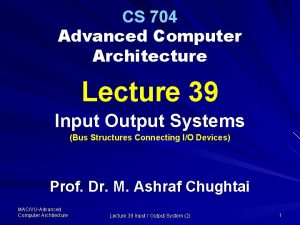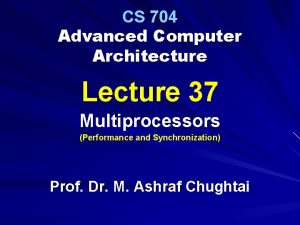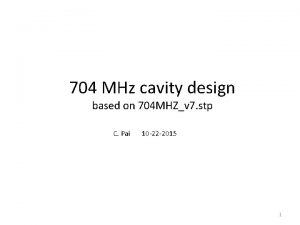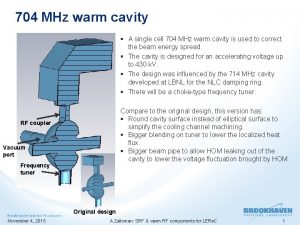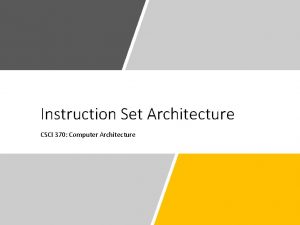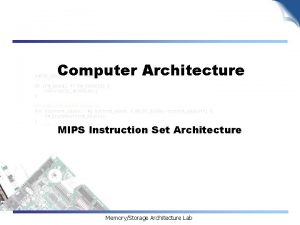CS 704 Advanced Computer Architecture Lecture 19 Instruction


































































- Slides: 66

CS 704 Advanced Computer Architecture Lecture 19 Instruction Level Parallelism (Limitations of ILP and Conclusion) Prof. Dr. M. Ashraf Chughtai

Today's Topics Recap Limitations of ILP - Hardware model - Effects of branch/jumps - finite registers Performance of Intel P 6 Micro-Architecturebased processors - Pentium Pro, Pentium II, III and IV Thread-level Parallelism Summary MAC/VU-Advanced Computer Architecture Lecture 19 – Instruction Level Parallelism-Dynamic (8) 2

Recap: ILP- Dynamic Scheduling In the last few lectures we have been discussing the concepts and methodologies, which have been introduced during the last decade, to design high-performance processors Our focus has been the hardware methods for instruction level parallelism to execute multiple instructions in pipelined datapath MAC/VU-Advanced Computer Architecture Lecture 19 – Instruction Level Parallelism-Dynamic (8) 3

Recap: ILP- Dynamic Scheduling These hardware techniques are referred to as Dynamic Scheduling techniques These techniques are used to ovoid structural, data and control hazards and minimize the number of stalls to achieve better performance We have discussed dynamic scheduling in integer pipeline datapath and in floatingpoint pipelined datapath MAC/VU-Advanced Computer Architecture Lecture 19 – Instruction Level Parallelism-Dynamic (8) 4

Recap: ILP- Dynamic Scheduling We discussed the score-boarding and Tomasulo’s algorithm as the basic concepts for dynamic scheduling in integer and floating-point datapath The structures implementing these concepts facilitate out-of-order execution to minimize data dependencies thus avoid data hazards without stalls MAC/VU-Advanced Computer Architecture Lecture 19 – Instruction Level Parallelism-Dynamic (8) 5

Recap: ILP- Dynamic Scheduling We also discussed branch-prediction techniques and different types of branchpredictors, used to reduce the number of stalls due to control hazards The concept of multiple instructions issue was discussed in details This concept is used to reduce the CPI to less that one, thus, the performance of the processor is enhanced MAC/VU-Advanced Computer Architecture Lecture 19 – Instruction Level Parallelism-Dynamic (8) 6

Recap: ILP- Dynamic Scheduling Last time we talked about the extensions to the Tomasulo’s structure by including hardware-based speculation It allows to speculate that branch is correctly predicted, thus may execute outof-order but commit in-order having confirmed that the speculation is correct and no exceptions exist MAC/VU-Advanced Computer Architecture Lecture 19 – Instruction Level Parallelism-Dynamic (8) 7

Today’s topics ILP- Dynamic Scheduling Today we will conclude our discussion on the dynamic scheduling techniques for Instruction level parallelism by introducing an ideal processor model to study the: limitations of ILP; and implementation of these concepts in Intel P 6 Micro-architecture MAC/VU-Advanced Computer Architecture Lecture 19 – Instruction Level Parallelism-Dynamic (8) 8

Limitations of the ILP – Ideal Processor To understand the limitations of ILP, let us first define an ideal processor. - An ideal processor is one which doesn’t have artificial constraints on ILP; and - the only limits in such a processor are those imposed by the actual data flows through either registers or memory MAC/VU-Advanced Computer Architecture Lecture 19 – Instruction Level Parallelism-Dynamic (8) 9

Assumptions for an Ideal processor An ideal processor is, therefore, one wherein: a) all control dependencies and b) all but true data dependencies are eliminated The control dependencies are eliminated by assuming that the: branch and Jump predictions are perfect, i. e. , MAC/VU-Advanced Computer Architecture Lecture 19 – Instruction Level Parallelism-Dynamic (8) 10

Assumptions – Control Dependencies i. e. , all conditional branches and jumps (including indirect jumps used for return etc. , ) are predicted exactly; and the processor has perfect speculation and an unbounded buffer of instructions for execution MAC/VU-Advanced Computer Architecture Lecture 19 – Instruction Level Parallelism-Dynamic (8) 11

Assumptions – Data Dependencies All but true data dependencies are eliminated by assuming that: a) There are infinite number of virtual registers available facilitating: - register renaming thus avoiding WAW and WAR hazards); and - Simultaneous execution of an unlimited number of instructions MAC/VU-Advanced Computer Architecture Lecture 19 – Instruction Level Parallelism-Dynamic (8) 12

Assumptions – Data Dependencies b) All memory addresses are known exactly facilitating: to move a load before a store, provided that the addresses are not identical MAC/VU-Advanced Computer Architecture Lecture 19 – Instruction Level Parallelism-Dynamic (8) 13

Ideal hardware model Hence, by combining these assumptions, we can say that in an ideal processor: – Can issue unlimited number of instructions, including the load and store instructions, in one cycle – All functional units have latencies of one cycle, so the sequence of dependent instruction can issue on successive cycles MAC/VU-Advanced Computer Architecture Lecture 19 – Instruction Level Parallelism-Dynamic (8) 14

Ideal hardware model – any instruction, in the execution of a program, can be scheduled on the cycle immediately following the execution of the predecessors on which it depend; and – the last dynamically executed instruction in the program, can be scheduled on the very first cycle MAC/VU-Advanced Computer Architecture Lecture 19 – Instruction Level Parallelism-Dynamic (8) 15

Performance of a Nearly Ideal Processor Now let us examine the ILP in one of the most advanced superscalar processor Alpha 21264 has the following features: – Issues up to 4 instructions/cycle – Initiates execution on up to 6 instructions – Supports large set of renaming registers – (41 -integer and 41 floating-point) – Uses large tournament type predictor MAC/VU-Advanced Computer Architecture Lecture 19 – Instruction Level Parallelism-Dynamic (8) 16

Performance of a Nearly Ideal Processor In order to examine the ILP in this processor a set of six (6) SPEC 92 benchmarks (programs), compiled on MIPS optimizing compiler are run. The features of theses benchmarks are: MAC/VU-Advanced Computer Architecture Lecture 19 – Instruction Level Parallelism-Dynamic (8) 17

Performance of a Nearly Ideal Processor The three of these benchmarks are floating point benchmarks: - Fpppp - Doduc - Tomcatv The integer programs are given as follows, – gcc – espresso – li MAC/VU-Advanced Computer Architecture Lecture 19 – Instruction Level Parallelism-Dynamic (8) 18

Performance of a Nearly Ideal Processor Now let us have a look on the performance Alpha 21264 for average amount of parallelism defined as number of instruction -issues per cycle for these benchmarks Fig 3. 35 MAC/VU-Advanced Computer Architecture Lecture 19 – Instruction Level Parallelism-Dynamic (8) 19

Performance of a Nearly Ideal Processor Here, you can see that fpppp and tomcatv have extensive parallelism so have high instruction-issues Where as the doduc parallelism doesn't occur in simple loop as it does in fpppp and tomcatv The integer program li is a LISP interpreter that has many short dependences so offers lowest parallelism MAC/VU-Advanced Computer Architecture Lecture 19 – Instruction Level Parallelism-Dynamic (8) 20

Performance of a Nearly Ideal Processor Now let us discuss how the parameters which define the performance of a realizable processor are limited in ILP The important parameters to be studied are: – Window Size and Issue Count – Branch and Jump predictors – Finite number of registers MAC/VU-Advanced Computer Architecture Lecture 19 – Instruction Level Parallelism-Dynamic (8) 21

Window size and Issue count In dynamic scheduling, every pending instruction must look at every completing instruction for either of its operand. A window in ILP processor is defined as: ‘‘a set of instructions which is examined for simultaneous execution’’ MAC/VU-Advanced Computer Architecture Lecture 19 – Instruction Level Parallelism-Dynamic (8) 22

Window size and Issue count Start of the window is the earliest uncompleted instruction and the last instruction in the window determines its size As each instruction in the window must be kept in the processor till the completion of execution, therefore The total window size is limited by the storage, number of comparisons and issue rate MAC/VU-Advanced Computer Architecture Lecture 19 – Instruction Level Parallelism-Dynamic (8) 23

Window size and Issue count The number of comparisons required every clock cycle is equal to the product: maximum completion rate x window size x number of operands per instruction For example, if maximum completion rate = 6 IPC window size = 80 instructions number of operands per instruction = 2 operands Then maximum comparisons required = 6 x 80 x 2 = 960 MAC/VU-Advanced Computer Architecture Lecture 19 – Instruction Level Parallelism-Dynamic (8) 24

window size and issue count In real processors, maximum number of instructions that may issue, execute and commit in the same clock cycle, is smaller than the window size Now let us see the effect of restricting window size on the instruction-issues per cycle MAC/VU-Advanced Computer Architecture Lecture 19 – Instruction Level Parallelism-Dynamic (8) 25

window size and maximum issue count Fig 3. 36… MAC/VU-Advanced Computer Architecture Lecture 19 – Instruction Level Parallelism-Dynamic (8) 26

Window size and maximum issue count Here, we assume that The instructions in the window are obtained by perfectly predicting branches and selecting instructions until the window is full. Here, you can see that the amount of the parallelism uncovered falls sharply with decreasing window size – e. g. ; MAC/VU-Advanced Computer Architecture Lecture 19 – Instruction Level Parallelism-Dynamic (8) 27

Window size and maximum issue count for the benchmark gcc when window size decreases from 2 K to 512 parallelism falls from 35 to 10 IPC and parallelism reduces to almost zero when window size is 4 Also note that the parallelism in the integer and FP program is almost similar for a specific window size MAC/VU-Advanced Computer Architecture Lecture 19 – Instruction Level Parallelism-Dynamic (8) 28

Branch and jump prediction Now let us discuss effect of realistic branch and jump prediction Our ideal processor assumes that the branches can be perfectly predicted but no real processor can achieve this Let us have a look on to this graph which shows the effect of realistic prediction schemes, which we have already discussed MAC/VU-Advanced Computer Architecture Lecture 19 – Instruction Level Parallelism-Dynamic (8) 29

Realistic branch and jump prediction Fig 3. 38… MAC/VU-Advanced Computer Architecture Lecture 19 – Instruction Level Parallelism-Dynamic (8) 30

Realistic branch and jump prediction This graph shows the parallelism for five different levels of predictions 1) Perfect At the start of execution all the branches and jumps are perfectly predicted and its gives highest parallelism 2) Tournament based branch predictor The second step tournament based branch predictor is considered MAC/VU-Advanced Computer Architecture Lecture 19 – Instruction Level Parallelism-Dynamic (8) 31

Realistic branch and jump prediction This scheme uses 2 -bit correlating and 2 -bit non-correlating predictor with a selector Predictor buffer consists of 8 K entries, each consists of three 2 -bit fields, that is, 48 K bits, both the correlating and non correlating It achieves the average accuracy of 97% of the six SPEC 92 benchmark MAC/VU-Advanced Computer Architecture Lecture 19 – Instruction Level Parallelism-Dynamic (8) 32

Realistic branch and jump prediction The graph shows the extensive difference among the programs: with loop-level parallelism (tomcatv and fpppp) and those without, i. e. , integer programs and doduc MAC/VU-Advanced Computer Architecture Lecture 19 – Instruction Level Parallelism-Dynamic (8) 33

Realistic branch and jump prediction The 3 rd level using Standard 2 bit predicator with 512 2 -bit entries and 4 th level using profile history of the program give almost identical results The 5 th level – None - where no branch prediction is used, though jumps are still predicted, the parallelism is largely limited to within a basic look MAC/VU-Advanced Computer Architecture Lecture 19 – Instruction Level Parallelism-Dynamic (8) 34

The effect of finite registers Another important limiting factor on the Instruction-issues per cycle is the finite registers. Ideal processor eliminates all name dependences among the register references assuming an infinite set of physical registers MAC/VU-Advanced Computer Architecture Lecture 19 – Instruction Level Parallelism-Dynamic (8) 35

The effect of finite registers To date, the Alpha 21264 has provided the largest number of extended registers i. e. 41 integer and 41 FP registers In addition 32 integer and 32 FP registers are provided The graph shows the effect of finite number of registers available for renaming using the same six SPEC 92 benchmarks MAC/VU-Advanced Computer Architecture Lecture 19 – Instruction Level Parallelism-Dynamic (8) 36

The effect of finite registers Fig 3. 41… MAC/VU-Advanced Computer Architecture Lecture 19 – Instruction Level Parallelism-Dynamic (8) 37

The effect of finite register Both the number of FP registers and the number of GP registers are increased Although, having only 32 extra FP and 32 extra GP registers has a significant impact on all the programs. But, the effect is most dramatic on the FP programs – (fpppp and tomcatv) – the instruction-issues increases from 10 to 45 IPC when registers increases from 32 to 128 MAC/VU-Advanced Computer Architecture Lecture 19 – Instruction Level Parallelism-Dynamic (8) 38

Effect of finite Registers Note that the reduction in available parallelism is significant when fewer than an unbounded number of renaming registers ( here, less than 32) are available For the integer programs the impact of having more than 64 registers is not seen here This is because of limitation in the window size. MAC/VU-Advanced Computer Architecture Lecture 19 – Instruction Level Parallelism-Dynamic (8) 39

Performance of realizable processors with realistic hardware Let us consider a processor with the following attributes 1) 2) up to 64 instructions per clock with no issue restriction, A tournament predictor with 1 K entries return predictors MAC/VU-Advanced Computer Architecture Lecture 19 – Instruction Level Parallelism-Dynamic (8) 40

Performance of realizable processors with realistic hardware 3) Perfect memory references done dynamically or through a memory dependence predictors 4) register renaming with 64 additional integer and 64 additional FP registers MAC/VU-Advanced Computer Architecture Lecture 19 – Instruction Level Parallelism-Dynamic (8) 41

Limitations on ILP for realizable processors Fig 3. 45… MAC/VU-Advanced Computer Architecture Lecture 19 – Instruction Level Parallelism-Dynamic (8) 42

Limitations on ILP for realizable processors This configuration is more complex and expensive then any existing implementations, especially in terms of number of instructions issue. The fig shows the results of the configuration as we vary the window size up to 64 issue per clock MAC/VU-Advanced Computer Architecture Lecture 19 – Instruction Level Parallelism-Dynamic (8) 43

Limitations on ILP for realizable processors Here, we assume that although there are fewer rename registers than the window size, the number of rename registers equals the issue width. All the operations have zero latency The fig shows the effect of the window size for the integer programs is not as severe as for the FP programs. MAC/VU-Advanced Computer Architecture Lecture 19 – Instruction Level Parallelism-Dynamic (8) 44

Putting it all together The Intel p 6 micro-architecture forms the basis for the Pentium pro, Pentium II and Pentium III These three processors differ in clock rate, cache architecture, and memory interface The Pentium pro, the processor and specialized cache SRAM’s were integrated into multichip module In the Pentium II standard SRAM’s are used as caches MAC/VU-Advanced Computer Architecture Lecture 19 – Instruction Level Parallelism-Dynamic (8) 45

Putting it all together In the Pentium III, there is either an on chip 256 KB L 2 cache or an off chip 512 KB cache. The P 6 micro architecture is dynamically scheduled processor that: translates each IA-32 instruction to a series of micro-operations (uops) that are executed by the pipeline; MAC/VU-Advanced Computer Architecture Lecture 19 – Instruction Level Parallelism-Dynamic (8) 46

Putting it all together The maximum number of uops that may be generated per clock cycle is six, with four allocated to the first IA-32 instructions The uops are executed by an out of order speculative pipeline using register remaining and a ROB MAC/VU-Advanced Computer Architecture Lecture 19 – Instruction Level Parallelism-Dynamic (8) 47

Performance of the Pentium pro implementation The Pentium pro has the smallest set of primary caches among the p 6 based microprocessors. Its has high bandwidth interface to the secondary caches. MAC/VU-Advanced Computer Architecture Lecture 19 – Instruction Level Parallelism-Dynamic (8) 48

Branch performance and speculation costs Branch target addresses are predicted with a 512 entry branch target buffer (BTB). If the BTB does not hit, a static prediction is used. Backward branches are predicted taken (and have a one cycle penalty if correctly predicted ). Forward branches are predicted not taken and have no penalty if correctly predicted). MAC/VU-Advanced Computer Architecture Lecture 19 – Instruction Level Parallelism-Dynamic (8) 49

Branch performance and speculation costs Branch mispredicts have both a direct performance penalty, which is between 10 and 15 cycles. Also indirect penalty due to the overhead of incorrectly speculated instructions. Which is essentially impossible to measure. Fig 3. 54… MAC/VU-Advanced Computer Architecture Lecture 19 – Instruction Level Parallelism-Dynamic (8) 50

Branch performance and speculation costs Fig 3. 54… MAC/VU-Advanced Computer Architecture Lecture 19 – Instruction Level Parallelism-Dynamic (8) 51

Branch performance and speculation costs It shows the fraction of the branches mispredicted either because of BTB misses or because of incorrect predictions. On average about 20% of the branches either miss or are mispredicted and use the simple static predictors rule. MAC/VU-Advanced Computer Architecture Lecture 19 – Instruction Level Parallelism-Dynamic (8) 52

Overall Performance of P 6 Pipeline Overall performance depends on the rate at which instructions actually complete and commit. Fig. . MAC/VU-Advanced Computer Architecture Lecture 19 – Instruction Level Parallelism-Dynamic (8) 53

Overall Performance of P 6 Pipeline Fig 3. 56… The fig shows the fraction of the time in which zero, one, two or three uops commit. On the average, one uop commits per cycle. MAC/VU-Advanced Computer Architecture Lecture 19 – Instruction Level Parallelism-Dynamic (8) 54

Overall Performance of P 6 Pipeline Here, 23% of the time, three uops commit in a cycle. This distribution demonstrates the ability of a dynamically scheduled pipeline to fall behind on 55% of the cycles, no uops commit) and later catch up (31% of the cycles have two or three uops committing) MAC/VU-Advanced Computer Architecture Lecture 19 – Instruction Level Parallelism-Dynamic (8) 55

The Pentium III versus Pentium 4 The micro architecture of the Pentium 4, which is called Net Burst, is similar to that of the Pentium III, called the P 6 micro architecture. Both fetch up to three IA-32 instructions per cycle, decode them into micro-ops. Then sends the uops to an out-of-order execution engine that executes up to three uops per cycle. MAC/VU-Advanced Computer Architecture Lecture 19 – Instruction Level Parallelism-Dynamic (8) 56

The Pentium III versus Pentium 4 There are, however, many differences which allow Net Burst micro architecture to operate at a significantly higher clock rate than the P 6 micro architecture These differences also help to maintain, or close to maintain, the peak to sustained execution throughput. MAC/VU-Advanced Computer Architecture Lecture 19 – Instruction Level Parallelism-Dynamic (8) 57

Differences in Pentium III versus Pentium 4 1) Net. Burst has a much deeper pipeline than P 6 requires about 10 clock cycles time for a simple add instruction, from fetch to the availability of its results In comparison, Net Burst takes about 20 clock cycles, including 2 cycles reserved simply to drive results across the chip, MAC/VU-Advanced Computer Architecture Lecture 19 – Instruction Level Parallelism-Dynamic (8) 58

The Pentium III versus Pentium 4 2) Net Burst uses register renaming (as in the MIPS R 10 K and the Alpha 21264) rather than the reorder buffer, which is used in P 6. Use of register renaming allows many more outstanding results i. e. , potentially up to 128 results versus the 40 permitted in P 6. MAC/VU-Advanced Computer Architecture Lecture 19 – Instruction Level Parallelism-Dynamic (8) 59

The Pentium III versus Pentium 4 3) There are seven integer execution units in the Net Burst versus five in P 6. In addition an additional integer ALU and an additional address computation unit. An aggressive ALU (operating at twice the clock rate) and an aggressive data cache lead to lower latencies. MAC/VU-Advanced Computer Architecture Lecture 19 – Instruction Level Parallelism-Dynamic (8) 60

The Pentium III versus Pentium 4 – The latency for the basic ALU operations is effectively one half of a clock cycle in Net Burst versus one in P 6) – The latency for data loads is effectively two cycles in Net Burst versus three cycles in P 6) These high-speed functional units are critical to lowering the potential increase in stalls from the very deep pipeline. MAC/VU-Advanced Computer Architecture Lecture 19 – Instruction Level Parallelism-Dynamic (8) 61

The Pentium III versus Pentium 4 4) Net Burst uses a sophisticated trace cache to improve instruction fetch performance, while P 6 uses a conventional Prefetch buffer and instruction cache. 5) Net Burst has a branch target buffer that is eight times larger and has an improved prediction algorithm MAC/VU-Advanced Computer Architecture Lecture 19 – Instruction Level Parallelism-Dynamic (8) 62

The Pentium III versus Pentium 4 6) Net Burst has 8 KB Level-I data cache as compared to P 6 that has 16 KB Level-I data cache. However, the Net Burst has larger Level-2 cache (256 KB) with higher bandwidth MAC/VU-Advanced Computer Architecture Lecture 19 – Instruction Level Parallelism-Dynamic (8) 63

The Pentium III versus Pentium 4 7) Net Burst implements the new SSE 2 FP instructions that allow two FP operations per instruction These operations are structured as 12 -bit SIMD or short-vector structure. This gives Pentium 4 a considerable advantage over Pentium-III on FP code. MAC/VU-Advanced Computer Architecture Lecture 19 – Instruction Level Parallelism-Dynamic (8) 64

Summary MAC/VU-Advanced Computer Architecture Lecture 19 – Instruction Level Parallelism-Dynamic (8) 65

Allah Hafiz MAC/VU-Advanced Computer Architecture Lecture 19 – Instruction Level Parallelism-Dynamic (8) 66
 Architecture lecture notes
Architecture lecture notes Isa computer architecture
Isa computer architecture Instruction format in computer architecture
Instruction format in computer architecture State diagram in computer architecture
State diagram in computer architecture Pipelining in computer architecture examples
Pipelining in computer architecture examples Ilp computer architecture
Ilp computer architecture Chapter 4 example
Chapter 4 example Instruction set architecture in computer organization
Instruction set architecture in computer organization Review of fundamentals of cpu
Review of fundamentals of cpu Odbern
Odbern Afi 36 704
Afi 36 704 704-631-1500
704-631-1500 704 marking system
704 marking system Target allocation partnership
Target allocation partnership Dot
Dot Iso 704
Iso 704 704 kar 3:305
704 kar 3:305 704 error
704 error 01:640:244 lecture notes - lecture 15: plat, idah, farad
01:640:244 lecture notes - lecture 15: plat, idah, farad Instruction de lecture
Instruction de lecture Advanced inorganic chemistry lecture notes
Advanced inorganic chemistry lecture notes Bus design in computer architecture
Bus design in computer architecture Individualized instruction vs differentiated instruction
Individualized instruction vs differentiated instruction § 367 abgb
§ 367 abgb 3 6 9 spare system chart
3 6 9 spare system chart Computer architecture and organization difference
Computer architecture and organization difference Flowchart for memory reference instructions
Flowchart for memory reference instructions Marie instruction
Marie instruction Stack isa example
Stack isa example Very long instruction word architecture
Very long instruction word architecture Mips instruction set architecture
Mips instruction set architecture Very long instruction word architecture
Very long instruction word architecture Arm instruction set architecture
Arm instruction set architecture Which instruction set architecture is used in beaglebone?
Which instruction set architecture is used in beaglebone? Instruction set architecture
Instruction set architecture Architecture
Architecture Mips code
Mips code Very long instruction word
Very long instruction word Computer security 161 cryptocurrency lecture
Computer security 161 cryptocurrency lecture Computer-aided drug design lecture notes
Computer-aided drug design lecture notes Littleman computing
Littleman computing Contoh cai
Contoh cai Cisc complex instruction set computer
Cisc complex instruction set computer Risc instruction set example
Risc instruction set example Computer instruction
Computer instruction Advanced topics in computer science
Advanced topics in computer science Advanced computer graphics
Advanced computer graphics Advanced computer forensics
Advanced computer forensics Advanced computer forensics
Advanced computer forensics Software architecture definition
Software architecture definition Return architecture
Return architecture Fundamental and incidental interactions
Fundamental and incidental interactions Product architecture examples
Product architecture examples Computer organization and architecture 10th solution
Computer organization and architecture 10th solution Ocs architecture
Ocs architecture Virtual labs iit kharagpur
Virtual labs iit kharagpur Introduction to computer organization and architecture
Introduction to computer organization and architecture Timing and control in computer architecture
Timing and control in computer architecture Evolution and interpretation of computer architecture
Evolution and interpretation of computer architecture Dma controller in computer architecture
Dma controller in computer architecture Fp adder
Fp adder Immediate addressing mode
Immediate addressing mode Static interconnection network in computer architecture
Static interconnection network in computer architecture Smt in computer architecture
Smt in computer architecture Pseudo instructions
Pseudo instructions Collision vector in pipelining
Collision vector in pipelining μcm
μcm



